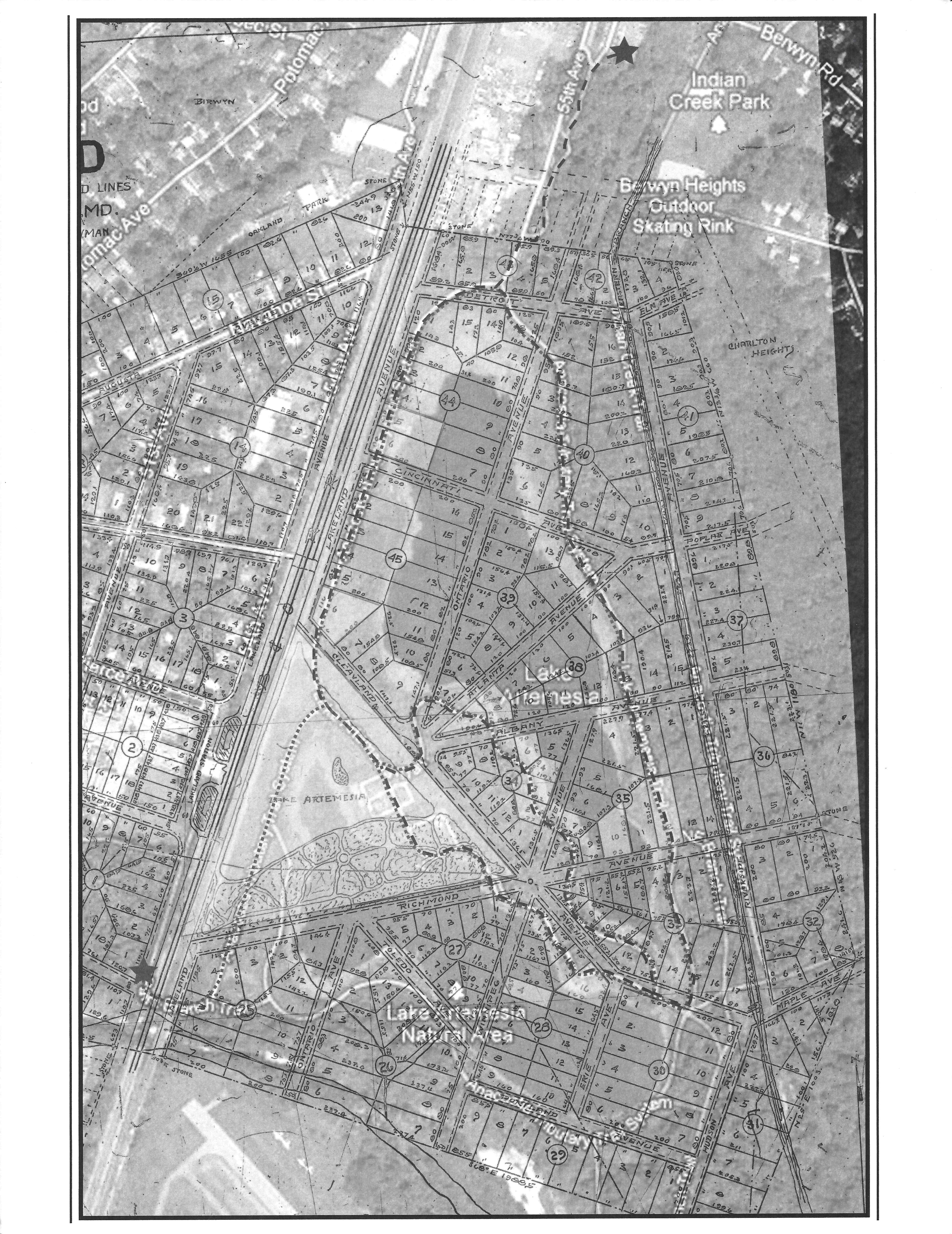
Eastern Lakeland
Historic Map and 2000s overlay Work of UMD students

Historic Map and 2000s overlay Work of UMD students

Evening Star May 12 1952

2021 Image of Lake Artemesia

After redevelopment as a public Natural Area

Photograph of Lake Artemesia Natural Area. The 38-acre park opened as a public facility in 1992. Located in what was once the eastern section of Lakeland (between the B&O railroad tracks--and now also the Washington Metrorail Green Line--and Berwyn Heights), it features aquatic gardens, fishing piers, and trails. The new Lake Artemesia is the product of builders dredging for gravel to elevate the rail bed that would carry commuter trains along Washington Metrorail's Green Line. Once the excavation was finished, the area was redeveloped and given to the local parks authority. The park stands on the former site of 30 Lakeland homes.

Lake Artemesia was initially dug in the mid-nineteenth century by the Baltimore and Ohio Railroad to retrieve gravel for use as ballast. It was later developed for recreational use by Edwin A. Newman in the 1890s. The lake was a center of recreation for the community, with swimming and fishing in summer and skating in winter. The lake was also the site of breeding ponds for the Baltimore Goldfish Company and later the U.S. Bureau of Fisheries.
Washington Post December 3, 2017 Page C3 John Kelly's Washington Henry Bishop, known as the “Gold Fish King” was a German immigrant who turned an interest in birds and fish into a successful business. His company sold the goldfish as well as aquariums, plants, ornaments, and food with the fish having their origin in Lakeland. Edwin Newman started his promotion of Lakeland with homes for sale on monthly payments. A main feature of the development was a park with Lake Artemisia. The lake was stocked with fish and outfitted with boats. Soon Mr. Bishop was using the body of water to raise his fish. In time there were about 25 acres of breeding ponds. The government also used pods in the area for breeding fish. A 1915 report detailed the excellent results of the operation in Lakeland. In Lakeland whites lived on the west while African Americans lived to the east. It is unclear when the use of fish ponds was discontinued. When the Metro’s Green Line was being built engineers realized the land in the are held sand and gravel which could’ve used for construction . One of their number Johann Sikkar proposed a cost saving measure of using that local gravel. Carrying out that plan resulted in a 38-acre park. Helping Hand Fundrasing campaign is underway to raise money for Bright Beginnings, N Street Village, and So Others Might Eat. The goal is $200,000 with $39,613 donated.
Evening Star May 11 1952
Contains: - The cover page contains various icons representative of Lakeland, such as the streetcar trolley sign and the railroad crossing; - The schedule for the weekend, detailing the events for the community party on Saturday and the religious service on Sunday; - An introductory piece, explaining the mission of the weekend and the Lakeland Community Heritage Project; - An overview of Lakeland history. Noted image of a house is the "Hicks house;" - Brief descriptions of Lakeland's churches and Lakeland's clubs.; - A description of the families of Lakeland and how they were forced out of their homes by Urban Renewal. Contains a description of the history and impact of Lake Artemesia; - More descripition of the erasure of a large part of the community, then recognition of how it's come back stronger than before; - A family tree template; - The order of service for the religious service on the Sunday., Empty space for notes and resources with which one could find their family history. On the right side, a map of eastern Lakeland; - The final page of the pamphlet, with thank-yous and acknowledgements.

Collection of ice from branch. Gathering of people at lake for ice skating. Washington Post
Washington Post January 27, 1924 PageSM5 Near Maryland Agricultural College is a fish breeding facility on Land leased by the government. It has been used to breed goldfish. Now 23 acres of the 75 acre tract is used for crappie, bluegill bream and large mouth bass. Fish from the facility are used to stock creeks and rivers in Maryland, Virginia, West Virginia, North Carolina, Delaware, New Jersey, Pennsylvania and New York. To test the conditions 23 acres were stocked and the results were very favorable. Experts are advocating for the new facility at Lakeland and say it would be a boost to the economy. US lags with other countries in their consumption of fish. The process used in raising the fish is similar to that used in producing chickens. The fish are transported using steel rail cars which carry 100 to 150 ten gallon containers holding 100 to 1,000 fish each.
Sunday Star May 11 1952